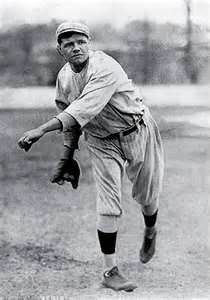Babe Ruth: Baseball's Titanic Presence
Part 1: In the Beginning Babe Ruth was one of American baseball's most famous, iconic, maddening, and talented players. He single-handedly played the way the game was played and the way fans regarded ballplayers. He powered the New York Yankees to dynasty status, setting 56 of the sport's records along the way. His fame and his various nicknames transcended his sport. Throughout his professional life, he was one of the most recognizable figures in America. He was born George Herman Ruth, Jr., on Feb. 6, 1895, in Baltimore, Md. He was only two of eight children both to German-born Kate and George Ruth who survived into adulthood. (His sister Mamie became famous as well.) A rambunctious, largely unsupervised child (mainly because his mother suffered from many illnesses), George Jr. adopted twin habits of skipping school and causing trouble when he wasn't in school, prompting his parents to opt for the monks at St. Mary's Industrial School for Boys to take charge of young George's further education. In the discipline of the school, he found something to like. The other thing he found to like was the sport of baseball, at which he particularly excelled from an early age. One of the monks at St. Mary's, Brother Matthias, served as a father figure to George and spent many hours helping the boy improve his baseball skills. Baltimore Orioles owner Jack Dunn was so taken with George's skills that he offered him a contract in 1914, when George was just 19. The salary was $250 a month. George accepted. (Dunn had to agree to become George's guardian as well because the minimum age for a pro player was 21.) When Dunn introduced George to his new name, the Orioles players termed him "Jack's newest babe," referring to his unadvanced age. The nickname stuck. 
Babe Ruth impressed Dunn and the Orioles almost immediately. He was a good all-around player, but Babe was particularly effective as a pitcher at this time. Seeing an opportunity, Dunn sold Babe to the Boston Red Sox, who promptly optioned him to the minor league Providence Grays. When the Grays won the International League pennant, Babe was promoted to the Red Sox, where he turned in a series of successful seasons. In 1915, his first full season in the major leagues, he recorded 18 wins and a respectable 2.44 earned run average (ERA). He was even better the following year, recording up a 23-12 record and leading the American League in ERA with a 1.75. The Red Sox won the World Series that year. Babe was even better on the mound in 1917, racking up 24 wins and 2.01 ERA. He also followed through on the hitting promise that he had shown during his training with Brother Matthias. During the 1918 season, the Red Sox played Babe more and more in the outfield. His specialty was hitting the ball a long, long way. He tied for the league lead that year, with 11. He still had a stellar year on the mound, with a 13-7 record and a dominating performance in the World Series, which the Red Sox won. The 1919 season was even more of a transition for Babe, as he started just 15 games and played more and more in the outfield. That year, he hit 29 home runs. Babe was a good hitter, not just a good long-ball hitter. His batting average in 191 was .322, which was among the league's best. He also had a good eye at the plate and racked up a lot of walks. As a result, Red Sox Harry Frazee could get a lot of money for Babe if he wanted to. Frazee did, it turned out, want a lot of money, so much so that he sold Babe Ruth to the New York Yankees at the end of the 1919 season for $125,000, more than twice what any team had paid for any player up to that time. It Ruth's subsequent performance for the Yankees and the Red Sox' subsequent performances without him led to a large number of individual and team records for the New Yorkers and an extraordinarily long string of disappointments for Red Sox fans. As such, the sale of Ruth came to be known as the "Curse of the Bambino." Next page > Building a Legend > Page 1, 2, 3 |
|
Social Studies for Kids
copyright 2002–2024
David White




